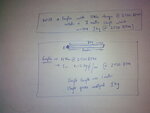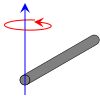abhi@eda
Member level 1

i am little confused about Torque which is measured in Newton meter...
Aussume,i have a engine which produces a 11Nm of torque at 2500RPM
the shaft of the engine is connected to a steel pipe which weighs 1kg..
so as far as i know,11Nm of torqe is the capacity of engine to turn something which weighs 11Newton and is connected to the center of the shaft at 1 meter distance...
so 11Nm is around 1.1kg-f ,so in the below image i have drawn the illustration,which shows a steel pipe of 1 meter long connected to the shaft,and weighs 1kg...
so the engine which produces over 1.1kg-f of force,can it turn the shaft when it is at rest? or will the engine stall and wont fire up??

Aussume,i have a engine which produces a 11Nm of torque at 2500RPM
the shaft of the engine is connected to a steel pipe which weighs 1kg..
so as far as i know,11Nm of torqe is the capacity of engine to turn something which weighs 11Newton and is connected to the center of the shaft at 1 meter distance...
so 11Nm is around 1.1kg-f ,so in the below image i have drawn the illustration,which shows a steel pipe of 1 meter long connected to the shaft,and weighs 1kg...
so the engine which produces over 1.1kg-f of force,can it turn the shaft when it is at rest? or will the engine stall and wont fire up??




